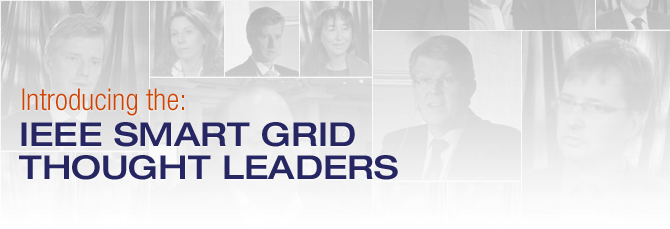Ralf Christian

The new IEEE Smart Grid Experts Video Spotlight has been well received since launching earlier this month. Next in the series is a conversation with Ralf Christian, Chief Executive of the Power Distribution Division of Siemens Energy. Ralf, an internationally recognized expert on Smart Grid, speaks from the IEEE Smart Grid World Forum on the global perspectives of Smart Grid and some of the differences between the United States and Europe.
VIDEO TRANSCRIPTION
[music]
If you look at the European and international level, it differs quite a lot from the U.S. perspective, and the big topic about smart grid in Europe is the large scale integration of renewable energies like wind, onshore as offshore, wind farms, and small photovoltaic generation into the power grids at low, medium, and high voltage levels.
[music]
Yes, there is such a thing as a European grid. At the high voltage level we have a continental grid at roughly 400 kilowatts in Europe that provides some capability of exchange of power between countries in Europe. Everything else is more at a national, regional, or even city level, which I would not call necessarily then a European integration.
The driving force, by and large, if I take an example. In Germany our government laws regarding in-feed tariffs, so for example if you connect, in Germany, the photovoltaic generation, very often small rooftop generation sites, you get a fixed amount of Euro cents per kilowatt hour for every kilowatt hour that you feed into the grid. That secures for you up to 25 years of secure income on your own private installation. Now this is outside of the control of the grid companies, because you have the freedom to buy those small generation capabilities as you want, you apply it, and then there is an obligation for the grid companies to connect you. This has spurred a huge increase in the number of those generation sites. Just to give you a number, this year alone in Germany there will be an additional 7 to 9 gigawatts of photovoltaic generation being installed on German rooftops.
[music]
In the public opinion, most likely as I can see it in Europe, specifically central and northern Europe, there is value in having a more sustainable and green infrastructure, and many people accept it. You have seen the emergence of so-called green parties in many parts of Europe. You even had a green party in Germany, in government, for many years, and those were those coalitions that have put those laws in place. There is more public resistance, for example, in Germany on nuclear power as there is, for example, on relatively high cost, green photovoltaic.
There is an opportunity for employment. Countries like Germany have generated a lot of jobs out of those new technologies. If you want to optimize the price per kilowatt hour, then green and sustainable technologies, as of today, are more expensive. So in principle, the great public will have to spend a little more on electricity that is generated green in Europe. So if you want to optimize, basically your price-cost scenario, then this would be viewed as not so positive, a negative scenario. If you want to have balanced view, the dependency on oil countries, many countries in Europe have to import fossil fuels, if you want to look at the environmental footprint of these things, public acceptance by and large is pretty broad and good for more higher prices on energy, because it's green.
[music]
There is, for example, a power market in place. In Germany, for example, the power market is located in the city of Leipzig. What is interesting is there is by law a priority to use green energy, wind energy. So when you have days when there is a lot of wind power generated, actually the power price at the stock market drops sometimes even below zero, which means you actually would get money if you could consume it. So there is a very high dependency today on power prices on the gigawatts being generated from wind, and so the market mechanism actually does not always reflect the true cost situation in this regard. But what you see clearly is that the huge amount of wind power capacity, that sometimes is there, sometimes isn't there if there's no wind, has a very major impact on market price.
[music]
We need to put this into perspective. The base load today, and if you look at the overall terawatts being generated, there is still today nearly 90% plus across Europe that is being generated from traditional sources like nuclear, like coal, like gas or hydro. So the total amount in terawatts being generated from renewable energy is, as of today, by far not a majority part and so it is still the minority part. So we still have today enough base load in the system to, basically, cover all situations, when there is no wind or no solar energy available.
[music]
The question for the future is, how do we optimize the system? How much backup power from traditional sources do we need as we increase in Europe more and more, based on those political will, the generation from renewables? That is a tricky question going forward. Do we need basically a one-to-one backup power, or can we develop more schemes where load management, demand side management can offset, somewhat, the requirement to have for very few days per years, basically, a peaker plant in place? So those questions are being dealt with only in the next years to come, because as of today there's still enough capacity in the system from traditional sources.
[music]
Okay. So one of those initiatives has a public name called Desertec, where many European companies regrouped in association. The point is that the transmission, in principle, is not a high cost element. The high cost element is the generation side, for example a concentrated solar power generation site, as you mentioned this. To put them in an ideal spot, like for example in northern Africa, just generates so much more value from that investment that you can easily pay off the transmission over 1,000 or 2,000 miles.
The problem with the concept, as of today, is that you need to build significantly more transmission capacity and that requires that you get the land and the allowances to build that transmission capacity and that will take time. With our democratic processes, it has to run through hundreds if not thousands of villages. You get to fight, basically, the local opinion, "That's not if my backyard. Please build it somewhere else." That will take time. But from a commercial point of view, it would make significantly more sense to build solar powered generation where there is a lot of solar power and then transmit it over longer distances. So commercially, this is a very viable option.
[music]
So looking 20 years ahead means we are in 2030. For sure, one thing will change in Europe, further on because it's part of the political agenda, basically, of all the European governments and the European Commission, we are going to see a significantly higher degree of electricity generated out of wind and solar, renewable sources.
The second topic, we are going to see at the regional, local level, even village level a significantly higher degree of autonomous electricity generation and consumption. There are a lot of mayors, for example, in villages in Europe that are exploring opportunities, you could call micro-grid, where decentral generation, for example, from biomass or small wind, small hydro, combined heat power generation, or photovoltaics in combination to a certain degree of influencing the load side, so smart technologies, basically to get a certain degree of autonomy from the large generation, from the large grid.
So I would see that Europe evolves in both directions. You're going to see more interchange of electricity, green electricity, solar generated from the south, wind form the north. So the capability and capacity of the grid will increase. We are talking terms like the European super grid. At the other end, we're going to see a higher degree of local decentral generation, even sometimes close to the autonomy of certain regions. I think we will see, basically, in both directions big investments.
The third element is that we are going to see, in 20 years from now, a large amount of the individual mobility in cities mainly with electric cars, plug-in hybrids. So the degree of the new technology within the total mobility in Europe will increase very significantly over the next 20 years.
So those are the three key topics I would say in this regard.
[music]
Well, there are a lot of different schemes in place across the different nations in Europe, but most of the European countries have supporting schemes, tax exemptions, other things in place, for example, to drive energy efficient buildings. To give you an example, personally I live in a home today which is fully electric. I generate the warm water as well as the heat in winter, fully electric with heat pumps for example. If you only go back ten years, you would say this wasn't necessarily efficient because the insulation of the house was not as good. Today, because you have good insulation, you have different systems in place, it makes perfect sense, even economically, to have your home completely electrical, no oil burner, no gas in-feed, in this regards.
So what we see across the board, if you look for energy efficiency, in most cases the solution is an electrically built solution. So from that end, we strongly believe as well that the degree of energy being consumed in the next two decades, that is coming from electricity, will increase significantly in relative share. While the total consumption will be reduced in Europe, the share of electricity keeps growing.
[music]
It's a mixed picture. Spain has reduced, for economic reasons, some of their schemes in the past years. Germany is completely hanging on. On the current feed-in tariffs, we see countries that haven't done a lot in the past and they're currently looking to what extent they can actually drive more investment into green technologies. So I would say across Europe it's probably not right to say that this is being reduced. There are some countries that had to reduce somewhat. Others are actually, if you look at the total amount being supported, it is increasing year by year. No change in law, but it's just a bigger number of installations that go into market every year. There are countries, specifically in Eastern Europe, that are currently looking for the first time to set up certain schemes.
[music]
For those who invest today, given the feed-in tariffs, in Germany it's an excellent investment. You get double digit returns on an annual basis if you invest in photovoltaics. Now if you take out the feed-in tariffs and say, "Well, some day we need to stop subsidizing renewable energies," there's a good likelihood that we have reached so-called retail grid parity. Basically, the amount that you need to pay to buy power for your home versus the cost that you have to generate power, that that will be reached within the next three to four years. So there is a good likelihood that by the end of this decade, by 2020 actually, on a retail price you are better off to generate your own photovoltaic electricity instead of buying it from the grid. So retail parity is in the neighborhood within the next years to come, even in northern countries like Germany.


